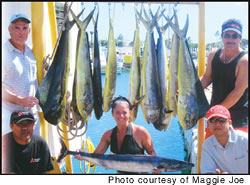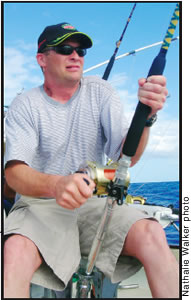Gone Fishin
A novice heads out to sea on a sportfishing adventure

By .(JavaScript must be enabled to view this email address)
E-mail this story | Print this page | Archive | RSS

This crew hauled in 11 mahimahi and one ono
board the Maggie Joe April 19, the day before
the author went fishing on the same boat
In the world of sportfishing, it’s all about size. It’s a competition between you and the deep blue, and the object of the game is to catch big.
It’s 5:45 a.m. and I’m boarding the Maggie Joe, a 53-foot custom sportfisher docked at Kewalo Basin, with MidWeek photographer Nathalie Walker. Our captains for the day are Mike Strait and Jason Berndt, and we’re joined by six friendly tourists.
It’s the first time either of us has gone fishing, or sportfishing for that matter. The closest experience for me was a few episodes of Fishing Tales with Mike Sakamoto and some memories of Hawaii Goes Fishing with Harry Kojima. So, here’s to our very first sportfishing adventure.
The boat takes off, and we watch as the sun starts to peek out from the horizon. A handful of dawn patrollers are already out surfing a south swell at Kewalos, while we prepare to catch some fish.
Capt. Strait starts by briefing us with a little history of the Maggie Joe, sportfishing
and some of the most commonly asked questions. He also has us pick cards to figure out who gets which rod.
“People always ask us, what’s an average day?” says Strait. “There’s never an average day. All it takes is one area of the ocean and one second to make it a good day of fishing. But you never know where or when or what’s going to bite or how big.
“The biggest fish ever caught on a rod and reel is an 1,805 pound Pacific blue marlin, and it was caught on a charter boat off Kewalo Basin. That’s one thing people aren’t aware of, that some of the best marlin is caught right here in waters off Oahu.”
Tip No. 1 before we even start talking about fish — be prepared for possible sea sickness. Our fellow shipmates suggest the scopolamine patch by Transderm Scop, a prescription medication that is usually easy to obtain with a simple call to your doctor, Dramamine and ginger capsules.
The boat continues to move forward, and then, at 9:06 a.m. we get our first catch. Scott Olsen of Oregon takes charge of pole No. 4 and after about 10 minutes of battle, he reels in a 25-pound mahimahi. What we didn’t know was that it was going to be our only catch of the day.
“That wasn’t bad, it was very enjoyable,” says Olsen, who is a sportfishing regular. “The whole time I was just trying to keep the line tight. I think it makes a huge difference that I already have experience in sportfishing. But this wasn’t a real big fish. Also, this boat is set up with the gear to catch big fish and having the right gear makes a big difference. And the guides were very informative. “What was going through my mind was just trying not to lose him. It would’ve been disappointing if I reeled him in and he broke off right at the end and got away.”
It was exciting to watch Olsen “fight” the fish. We cheered him on, waiting anxiously anxiously to see what was at the end of his line, and when the catch came in, we applauded him as if he had won the match of his life. Ironically, Olsen doesn’t even like the taste of fish, but he says the “not knowing what you’re going to hook into next” makes sportfishing fun and thrilling for him.
“It’s a competitive thing,” he says. “That’s the cool thing about it. Fishing out here, there’s a good chance that you could hook something big.”
Each charter has its own fish policy, so you may want to check before booking. On the Maggie Joe, for anything under 100 pounds, the passenger is entitled to up to half of the catch. And anything over 100 pounds, the boat keeps.
“We do everything, all you have to do is crank the fish in,” instructs Berndt. “All the lines are attached to the outriggers or tag lines (to the sides of the boat) and that helps to spread the lines out. They all have self-releasing clips, so when the fish bites, the clip pops open and you fight directly from the pole.”
“The chance of all eight of us catching fish is possible but not likely,” adds Strait. “What we do is we rotate the rods, so if one lure is catching a lot of fish, it gets alternated.
“Currently in Hawaii, there are no rules, limits or regulations for offshore fishing. You don’t need a license to do this. Though in the future they might put a quota on the fish you can take, and they might start having passengers buy licenses.”
According to the American Sportfishing Association, fishing consistently ranks at the top in participation among outdoor sports. The U.S. Fish and Wildlife Service reported 44 million people over the age of 6 went fishing in 2001, which means nearly one in every five Americans is an angler.

Scott Olsen hooks a big one
“Fishing is the No. 1 sport in the U.S.” says Strait. “More money is spent on fishing than any other sport because anybody can participate, whether you’re an 8-year-old kid or an 80-yearold grandma. We’re not commercial fishermen. It’s a bonus for us to sell the fish we catch. We’re the big game fishermen. We catch the small ones too, but we’re here to catch the biggest fish. To break the 1,805 pound fish record, and somebody will.”
Here comes tip No. 2 — don’t forget your sunblock, a hat, sunglasses, a camera, towel, lunch and snacks (no bananas, it’s considered bad luck on fishing boats in Hawaii). For us, the rest of the trip was spent sunbathing, napping, eating, relaxing and just enjoying the beauty of the sea. We even got a surprise visit by a few spinner dolphins.
Of course, the enjoyment wasn’t the case for everyone. We did have one victim of seasickness on board, and for her the experience could not have been any more miserable. For those who aren’t sure how their body will react to the sea, most charters offer 3/4 day trips, and even half-day trips.
Our day was coming to an end, and at 18 miles southwest from Kewalo Maggie Joe turned around and headed back to shore. I was slightly disappointed that I didn’t catch anything, but then again, before today I did n’t even know that a person like me — with no knowledge, certification or license to fish — could even go sportfishing. Plus, I’m an ocean person, so just being out on the water was worth every minute of my day.
“It was really nice and relaxing,” says Travis Bamford about his day on the Maggie Joe. “Just to have the chance to hook into something. That’s the thrill of fishing — you just don’t know what you’re going to catch or not catch. It’s kind of like gambling. You don’t know if you’re going to come home with the jackpot or with empty memories.”
That’s fishing, and the part they don’t show you on TV. Just one day before us, on the same boat, the crew caught 11 mahimahi and one ono. And just two days before us, on the same boat, someone caught a 430- pound marlin!
“Maggie Joe is the oldest sportfishing company in Hawaii, and it has the reputation of catching a lot of fish, but not all the time,” says Strait. “We want to catch fish more than the passengers want it. It makes us look good and it makes them happy. But if there’s no fish, there’s nothing we can do about it.”
Page 1 of 2 pages for this story 1 2 >
E-mail this story | Print this page | Comments (0) | Archive | RSS
Most Recent Comment(s):
Commenting is not available in this weblog entry.







